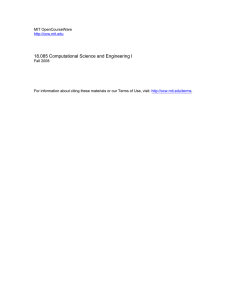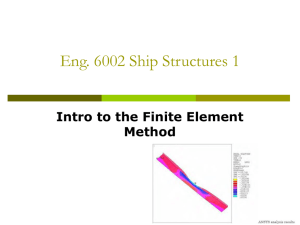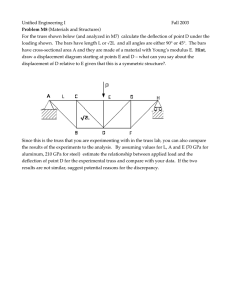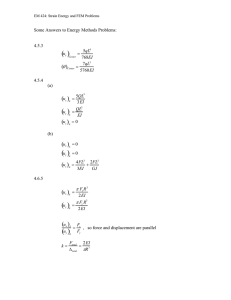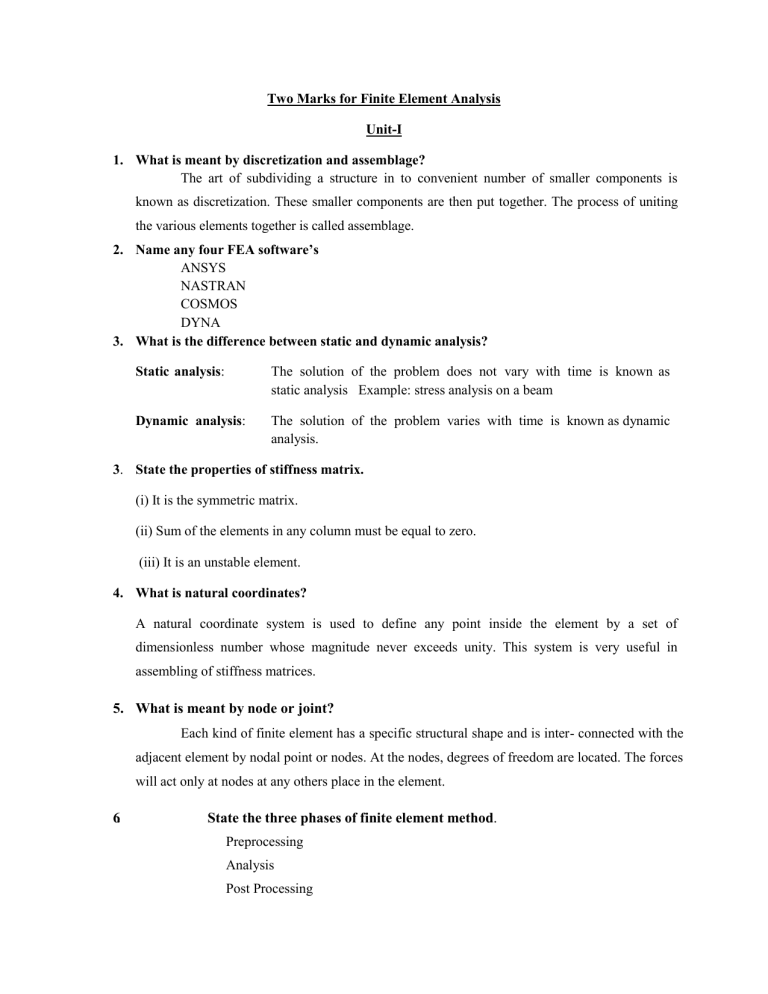
Two Marks for Finite Element Analysis Unit-I 1. What is meant by discretization and assemblage? The art of subdividing a structure in to convenient number of smaller components is known as discretization. These smaller components are then put together. The process of uniting the various elements together is called assemblage. 2. Name any four FEA software’s ANSYS NASTRAN COSMOS DYNA 3. What is the difference between static and dynamic analysis? Static analysis: The solution of the problem does not vary with time is known as static analysis Example: stress analysis on a beam Dynamic analysis: The solution of the problem varies with time is known as dynamic analysis. 3. State the properties of stiffness matrix. (i) It is the symmetric matrix. (ii) Sum of the elements in any column must be equal to zero. (iii) It is an unstable element. 4. What is natural coordinates? A natural coordinate system is used to define any point inside the element by a set of dimensionless number whose magnitude never exceeds unity. This system is very useful in assembling of stiffness matrices. 5. What is meant by node or joint? Each kind of finite element has a specific structural shape and is inter- connected with the adjacent element by nodal point or nodes. At the nodes, degrees of freedom are located. The forces will act only at nodes at any others place in the element. 6. State the three phases of finite element method. Preprocessing Analysis Post Processing Unit-II 1. What are the types of loading acting on the structure? Body force (f) Traction force (T) Point load (P) 2. Define the body force and traction force A body force is distributed force acting on every elemental volume of the body Unit: Force per unit volume. Example: Self weight due to gravity Traction force is defined as distributed force acting on the surface of the body. Unit: Force per unit area. Example: Frictional resistance, viscous drag, surface shear 3. What is Global coordinates? The points in the entire structure are defined using coordinates system is known as global coordinate system. 4. Why polynomials are generally used as shape function? Differentiation and integration of polynomial are quite easy. The accuracy of the result can be improved by increasing the order of the polynomial. It is easy to formulate and computerize the finite element equations. 5. What is truss and state the assumptions made in case of truss element A truss is an assemblage of bars with pin joints and a frame is an assemblage of beam elements. Truss can able to transmit load and it can deform only along its length. Loads are acting only at the joints. The following assumptions are made in the case of truss element, 1. All the members are pin jointed. 2. The truss is loaded only at the joints 3. The self weight of the members is neglected unless stated. 6. Define shape function & State its characteristics In finite element method, field variables within an element are generally expressed by the following approximate relation: u (x, y) = N1(x,y) u1+N2 (x,y) u2+ N3(x,y) u3 Where u1, u2, u3 are the values of the field variable at the nodes and N1 N2 N3 are interpolation function. N1 N2 N3 is called shape functions because they are used to express the geometry or shape of the element. The characteristics of the shape functions are follows: 1. The shape function has unit value at one nodal point and zero value at the other nodes. 2. The sum of the shape function is equal to one. 7. Write the governing equation for 1D Transverse and longitudinal vibration of the bar at one end and give the boundary conditions. The governing equation for free vibration of a beam is given by, Where, E – Young’s modulus of the material. I – Moment of inertia Ρ – Density of the material. A – Cross sectional area of the section of beam. The governing equation for 1D longitudinal vibration of the bar at one end is given by Where, U – axial deformation of the bar (m) ρ – Density of the material of the bar (kg/m3 ) ω – Natural frequency of vibration of the bar A – Area of cross section of the bar (m2 ) 7. Define initial value problem and boundary value problem An initial value problem is one in which the dependent variable and possibly is derivatives are specified initially. A differential equation is said to describe a boundary value problem if the dependent variable and its derivatives are required to take specified values on the boundary. 8. State the principle of minimum potential energy. Among all the displacement equations that satisfied internal compatibility and the boundary condition those that also satisfy the equation of equilibrium make the potential energy a minimum is a stable system. 9. Define total potential energy. Total potential energy, π = Strain energy (U) + potential energy of the external forces Unit-III 1. What is CST element? Three noded triangular elements are known as CST. It has six unknown displacement degrees of freedom (u1, v1, u2, v2, u3, v3). The element is called CST because it has a constant strain throughout it. 2. What is LST element? Six nodded triangular elements are known as LST. It has twelve unknown displacement degrees of freedom. The displacement function for the elements are quadratic instead of linear as in the CST. 3. What is QST element? Ten nodded triangular elements are known as Quadratic strain triangle. It is also called as cubic displacement triangle 4. What meant by plane stress analysis? Plane stress is defined to be a state of stress in which the normal stress and shear stress directed perpendicular to the plane are assumed to be zero. 5. Define plane strain analysis. Plane strain is defined to be state of strain normal to the x,y plane and the shear strains are assumed to be zero. 6. Define pure torsion A pair of forces of equal magnitude but opposite in direction acting on a body They form a couple that tends to twist the body. 7. Write down the stiffness matrix equation for two dimensional CST elements. Stiffness matrix [K] = [B] T [D] [B] At [B]T -Strain displacement [D]-Stress strain matrix [B]-Strain displacement matrix Unit-IV & V 1. What is axisymmetric element? Many three dimensional problem in engineering exhibit symmetry about an axis of rotation such type of problem are solved by special two dimensional element called the axisymmetric element. 2. What are the conditions for a problem to be axisymmetric? The problem domain must be symmetric about the axis of revolution All boundary condition must be symmetric about the axis of revolution All loading condition must be symmetric about the axis of revolution. 3. What is meant by Isoparametric element? If the number of nodes used for defining the geometry is same as number of nodes used for defining the displacement is known as Isoparametric element. 4. Define super parametric element. If the number of nodes used for defining the geometry is more than of nodes used for defining the displacement is known as super parametric element 5. Define sub parametric element. If the number of nodes used for defining the geometry is less than number of nodes used for defining the displacement is known as sub parametric element. 6. What is the purpose of Isoparametric element? It is difficult to represent the curved boundaries by straight edges finite elements. A large number of finite elements may be used to obtain reasonable resemblance between original body and the assemblage. 7. Differentiate the serendipity and langrangian elements Serendipity elements: In discretized element, if nodes lie on corner, then the element are known as serendipity elements. Langrangian elements: In discretized element, If nodes are present in both centre of element and corner are known as langrangian elements 8. Explain Gauss quadrature rule. The idea of Gauss quadrature is to select “n” Gauss points and “n” weight functions such that the integral provides an exact answer for the polynomial f(x) as far as possible, suppose if it is necessary to evaluate the following integral using end point approximation then


